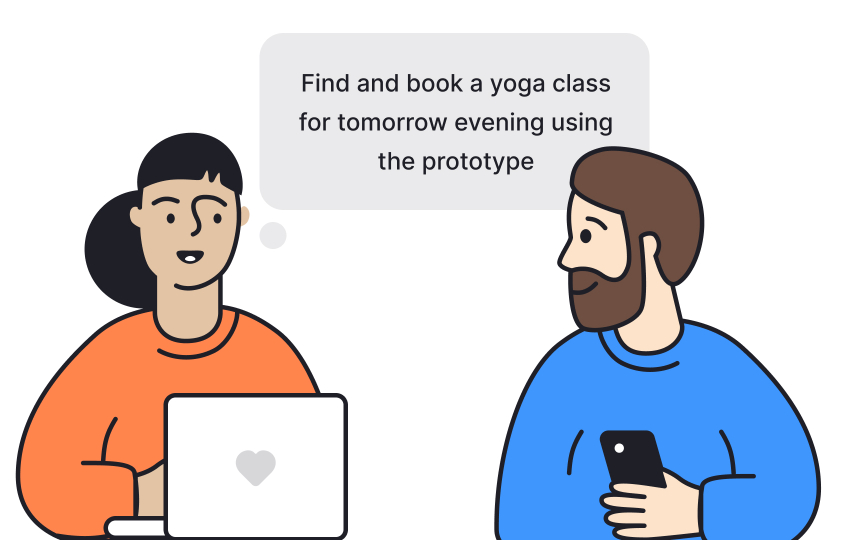Reviewing and Validating Specifications
Turn assumptions in your product spec into evidence through prototype testing and collaborative review.
Once specifications are written, their accuracy and usability must be tested before development begins. Reviewing and validating specifications is where ideas meet reality. A clear spec ensures feasibility, but only validation reveals if the proposed solution truly works for users.
This stage connects documentation with experience. Teams build low-fidelity prototypes to test how real users interact with the proposed features. By observing what feels intuitive and what causes friction, product teams identify missing details, unclear requirements, or unnecessary complexity. These insights guide precise adjustments to the specification, preventing costly rework later.
Validation does not replace review. It works alongside it to ensure both accuracy, relevance, internal clarity, consistency, and feasibility. It also checks real-world desirability and usability. Together, they close the loop between writing and building, helping teams confirm that they’re not only building the product right, but also the right product.
Reviewing and validating a specification serve different but complementary purposes in the product development process. A review focuses on internal quality. It checks whether every section of the document is clear, consistent, and technically feasible. The goal is to confirm that requirements are complete, measurable, and aligned with the project’s objectives before any design or build work begins. During this step, teams look for missing details, conflicting descriptions, and assumptions that could lead to confusion later.
Validation, by contrast, examines whether the proposed product solution will work for real users. It connects the written specification with real-world behavior by testing how people interact with
Before reviewing a product specification, it must be clear, organized, and detailed enough to guide discussion effectively. Each section should follow a logical order and use consistent language so that reviewers can easily locate information and spot potential gaps. Clear definitions of product goals, user needs, and technical constraints reduce ambiguity and ensure shared understanding among stakeholders.
The document should also link related elements, such as user stories and acceptance criteria, to demonstrate how each feature connects to business or user outcomes. Including structured sections like product summary, features, risks, and design details helps maintain alignment across teams.
A well-prepared specification provides measurable criteria that reviewers can evaluate for completeness and feasibility, ensuring the next stages of validation and
A peer review transforms specification writing from an isolated task into a collaborative quality check. The process brings together team members from product, design, and engineering to assess whether each requirement is clear, testable, and aligned with overall goals. A structured checklist helps reviewers evaluate aspects such as completeness, accuracy, and traceability. Each participant looks for inconsistencies, redundant details, and unclear dependencies that might cause problems during implementation.
Walkthrough sessions are particularly effective because they allow participants to question assumptions and clarify the reasoning behind design or technical decisions. These sessions are not meant to criticize but to verify that every feature described can be understood and executed by those who will build or test it. By combining different perspectives, teams strengthen the specification’s quality and prevent issues that often surface only during development.
Pro Tip: Use checklists and cross-functional walkthroughs to detect unclear logic or missing links before building anything.
Prototyping transforms written requirements into something tangible that users can interact with. Once the core features are defined, teams can create a basic clickable model using tools like Figma or Miro. This
These small insights are powerful. They highlight where requirements need clarification, where steps can be simplified, or where functionality is missing altogether. Teams can then revise the specification to include clearer instructions, adjusted labels, or an updated flow that matches how users actually behave. Testing at this stage ensures that the product spec evolves from assumptions into verified directions, making development smoother and more aligned with real-world use.
Pro Tip: When testing a prototype, stay silent. Watching users struggle or succeed without guidance reveals the most authentic insights.
User validation sessions help teams see whether the product specification reflects real user behavior. They are usually short, focused sessions where participants complete predefined tasks using a
During the session, the facilitator encourages participants to “think aloud,” describing what they expect to happen and what confuses them. Subtle cues, such as hesitation, scanning, or backtracking, often reveal unclear logic or missing guidance in the specification. Afterward, all observations are logged and connected to specific requirements or
A short session with 5 to 7 participants is often enough to uncover major
Pro Tip: Focus on watching, not explaining. The best usability insights appear when users try to figure things out on their own.
After validation sessions, teams must translate observations into structured insights. Raw notes, quotes, and metrics become useful only when organized and analyzed systematically. Start by clustering feedback into themes such as “navigation confusion” or “missing features.” Then
Prioritization is essential. Not every comment should trigger a change. Focus first on issues that block task completion or contradict user goals. For instance, if multiple users say that the “Apply filter” button feels unnecessary, this might be a minor preference. But if users repeatedly fail to notice the “Add to cart” button because it looks inactive, that points to a critical
Use qualitative data (like user quotes) alongside quantitative indicators (like task completion rates) to form a balanced view of what needs improvement. Synthesizing feedback in this way helps teams refine specs quickly and keep them grounded in user evidence rather than opinion.[2]
Pro Tip: Always link feedback to specific parts of the spec. It prevents insights from getting lost and turns opinions into actionable changes.
Once validation and feedback analysis are complete, the next step is to refine the specification so that it accurately reflects what users need and understand. Every change should be based on real evidence, not preference. Start by revisiting
Refinement also involves removing unnecessary details that add noise without helping the product perform better. For instance, including specific color codes or long technical notes inside the functional section distracts from what users are supposed to achieve. If you keep the sections simpler, team members will not lose focus. Just make sure they know where to look for the implementation details in related design or tech documents.
Teams should document all changes directly in the specification, noting why each edit was made and which feedback informed it. This keeps the document transparent and easy to follow. A refined specification captures not only what was planned, but what was actually proven to work well for users.
After updates are made, each requirement should be clear enough to test in practice. A testable specification gives teams a way to prove whether a goal has been achieved. To make a requirement measurable, describe what success looks like in specific terms. Instead of saying “The page should load quickly,” define a limit such as “The page loads in under three seconds on mobile.”
Testability can apply to different types of requirements:
- Functional: Confirm whether a user action triggers the right response (for example, “When clicking ‘Save,’ a confirmation appears within two seconds”).
- Usability: Measure how easily users complete key tasks (like “80% of participants complete
checkout without asking for help”). - Performance: Track system efficiency through metrics such as load time, frame rate, or error rate.
- Accessibility: Verify that
color contrast , keyboardnavigation , and screen readerlabels meet standards.
Creating a short table that links each requirement to its testing method, such as usability test, QA script, or analytics metric, helps ensure accountability. Clear, measurable statements make it possible to check progress objectively and avoid confusion during development.
Pro Tip: If a requirement can’t be observed, timed, or counted, it’s not ready for testing. Rewrite it until it can be.
After internal peer reviews and user validation, the specification needs a final alignment check with stakeholders. This stage is less about polishing the document’s clarity and more about confirming that its contents match broader business and technical goals. Product leads, engineers, designers, and other decision-makers come together to agree on what will move forward, what will wait, and what might need scope adjustments.
During this review, teams walk through each major section, especially features, timelines, and dependencies, and discuss trade-offs. For example, if a validated feature increases development time, stakeholders may decide to postpone it or release it later. The goal is to reach consensus so that everyone knows exactly what is being approved for the next phase. Recording key decisions directly in the document ensures visibility and accountability for all involved.
This step transforms the specification from a working draft into an agreed roadmap for development. Once approved, it becomes the shared reference point for execution.
Validation is not a one-time step. As projects evolve, specifications should evolve too. Treat the product spec as a living document that reflects what has been learned through new data, user feedback, or technical constraints. Schedule regular checkpoints, such as after sprint reviews or feature releases, to revisit whether the documented requirements still describe how the product works.
To make validation continuous, teams can:
- Reconnect user testing or analytics data back to specific requirements in the spec.
- Document every change, along with its reason and the evidence behind it.
- Use collaborative tools that store version history, comments, and updates in one place.
Continuous validation helps catch early deviations between what was planned and what is being delivered. Over time, this practice builds a specification that stays accurate, reliable, and reflective of real product behavior.
Pro Tip: Schedule lightweight spec reviews after every major product release. Staying updated takes less time than catching up later.
References
- How to write a technical specification [with examples] | monday.com Blog
Topics
From Course
Share
Similar lessons

Introduction to Design Audits

Assumption Testing




















